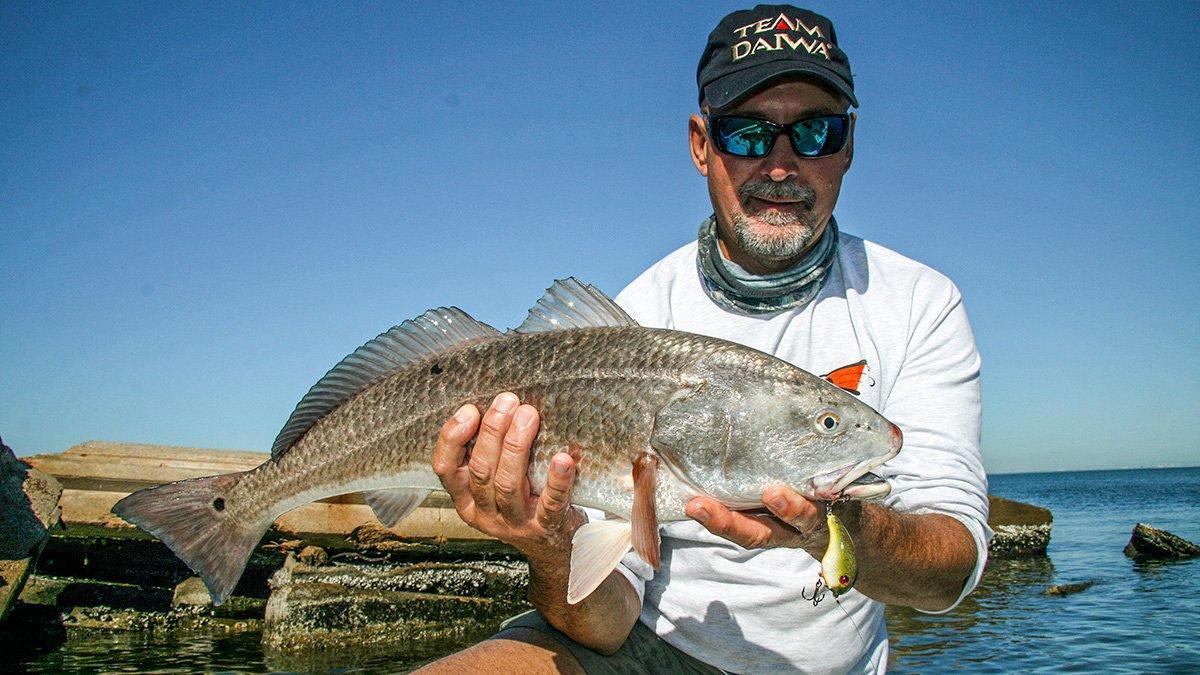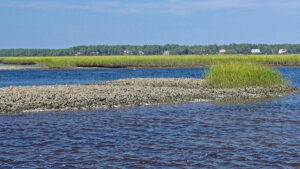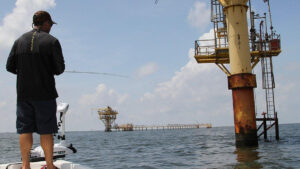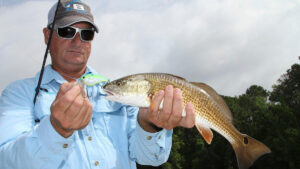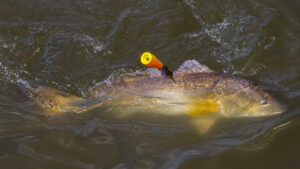So, we’re poking all the way into the back of a small creek off a St. Johns River tributary, upriver from Jacksonville, Fla. and about 15 miles from the Atlantic Ocean. Capt. Chris Holleman eases up to a couple of logs leaning off the bank and throws a shallow running crankbait.
Largemouth bass would’ve been the likely assumption and a green goblin might very well have frequented the area; but when the line came tight and Holleman swung his catch aboard, it bore copper scales and a black-spotted tail.
In coastal waters, you can’t go wrong by fishing hard objects for overlooked redfish.
Yes, we typically picture redfish grazing across a South Florida grass flat, or picking crabs off the Mississippi Delta Roseau cane – and those certainly can be productive scenarios. However, reds like their hard structure. Why? Because it typically harbors lots of those wiggly, crunchy things these fish like to eat.
Cover and tidal breaks don’t hurt, but the redfish is a gluttonous creature fond of frequenting the coastal vending machines.
Here’s a look at some of the most consistent redfish habitats of the harder variety.
OYSTERS
From scattered patches strewn along a backwater canal or a mangrove island, to prominent oyster colonies dotting a salt marsh, to the commercial shell beds of the Mississippi Delta and Florida’s Apalachicola Bay; anywhere these sharp-shelled bivalves exist, reds are likely to come snooping. With countless nooks, crannies and hidey holes for a host of crustacean and invertebrate forage – along with pinfish, mullet and various forage fish hovering around the structure, redfish find endless feeding opportunities along oyster bars.
NATURAL ROCK
Shallow rock reefs present navigational nightmares, but their redfish attraction is undeniable. From the “worm rock” of Baffin Bay (Texas) to the treacherous limestone reefs off Florida’s Homosassa / Crystal River region, these sites are like highway rest stops for reds traveling the coast. Some areas, like Black Rock Beach on Florida’s northeast corner stand fully exposed on a strong outgoing tide; but rest assured, the reds will march forth with the rising water.
PIERS/BRIDGES/DOCKS
Lots of structure means lots of foraging areas, while extensive hard surface attracts the various shellfish growth (oysters, barnacles, invasive Asian green mussels) that creates gathering areas for pinfish, shrimp, crabs and invertebrates upon which redfish like to chow. The regular tidal flushing also benefits redfish by delivering transient food sources.
JETTIES
Rocky mounds meant to shield navigational lanes, jetties host an abundance of marine life from small crustaceans to progressively larger forage fish. Not only do they offer a continuous grazing course, jetties, along with rock weirs like those of the Delta’s Southwest Pass, also serve as a sideline against which redfish corral their prey.
RIPRAP & RUBBLE
Similar in nature to jetties, this type of redfish habitat lacks the length factor, but creates concentrated focal points. This could be semi-emergent rock mounds built to fortify main span bridge pilings or facilities like the old Sand Island Lighthouse riprap outside of Alabama’s Mobile Bay, crumbling industrial seawalls and piers, or demolition rubble (either randomly piled, or installed as nearshore reefs).
DRILLING STRUCTURES
Built to harvest the Gulf of Mexico’s oil and natural gas, the various drilling platforms and pumping stations well within range of inshore boats (given favorable winds) offer fulltime residence for some of the northern and western Gulf’s adult “bull” reds. The fish tend to move around with the baitfish, but when you find rig reds, they’re the ones worth the run.
Opportunities exist throughout the Gulf’s drilling fields, as well as Mobile Bay’s inside rigs.
WHAT TO THROW
In most of these scenarios, free-lined shrimp and baitfish or fish finder rigs with cut menhaden or mullet are well received. Consider, how the complex structures of oyster beds, jetties and most any rock formations threaten frequent tackle confiscation.
In the snaggy spots, you’ll do better by bouncing buck tails or jigheads with shad tails along the structure, cranking the edges or slow rolling a heavy-gauge spinnerbait. If you prefer natural bait, use a popping cork to work above the entanglement zone.
Experienced redfish anglers often probe oyster bar and rock perimeters with weedless gold spoons. Notwithstanding their ability to bump along the gnarliest cover without snagging, these baits cast well – even in a stiff wind. This allows you to test shallow spots from a distance before moving in closer.
For bridges and piers, you might find a jigging spoon effective, as you work the vertical profile of pilings and flutter the bait through open lanes. On the drilling rigs, cast a 3/4- to 1-ounce jig up current and bounce it along the rig structure. Glow tails are a popular choice, as they help the fish find your bait in the dark water.
Consider your wind and current direction when fishing hard structure for reds. You’ll want to present baits as naturally as possible, but you’ll need to mind your presentations to minimize hang-ups. Crankbaits can be a lot of fun bounced on hard surfaces that aren’t too snaggy.
Also, during the cooler months, work the east-facing sides of a structure in the morning because that’s where the sun hits first.


